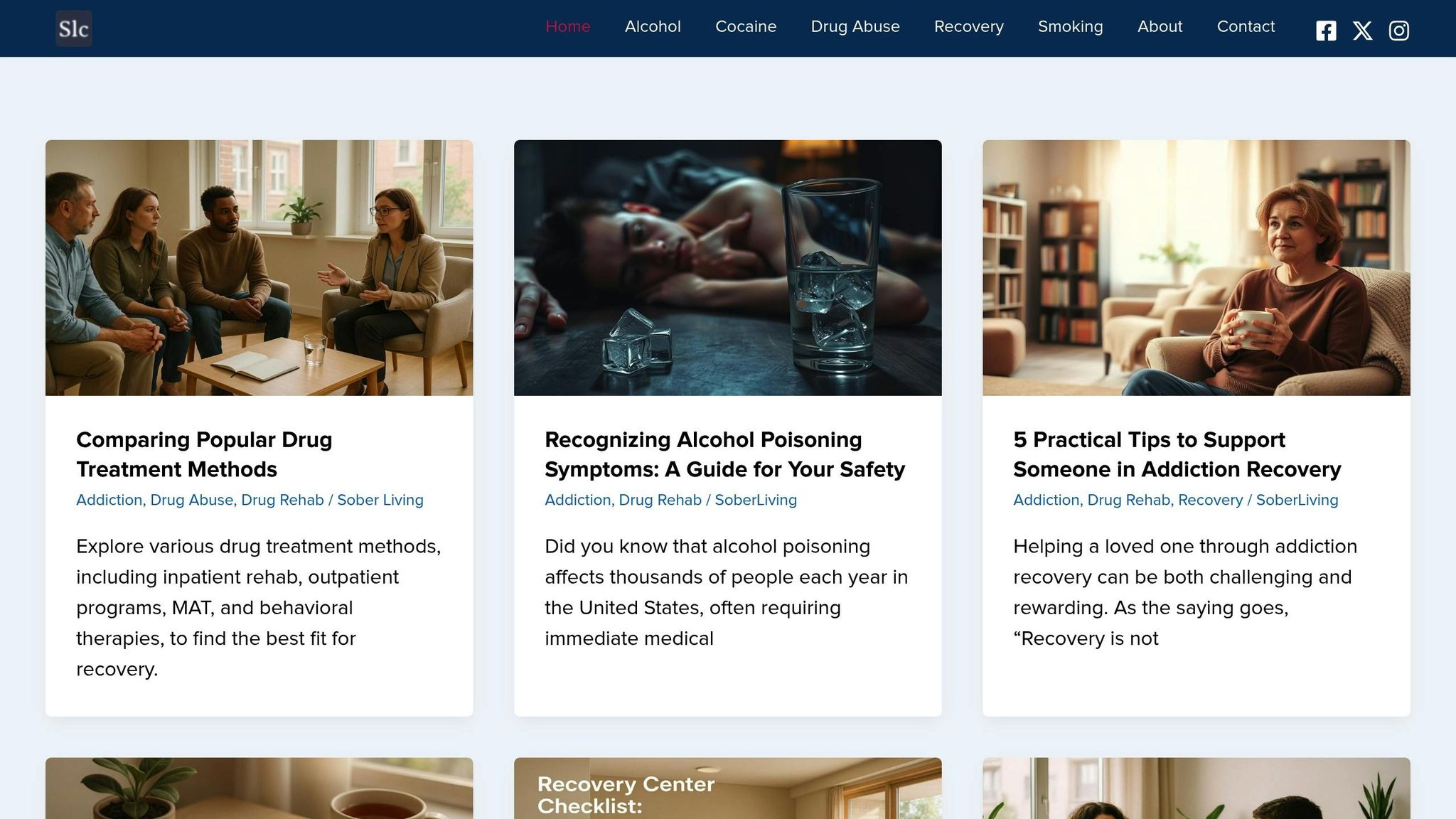Holistic addiction treatment focuses on addressing addiction by treating the mind, body, and spirit together. Unlike standard methods that primarily target substance use, this approach considers underlying factors like mental health, trauma, and social influences. It combines evidence-based therapies (e.g., CBT, medication) with alternative practices like mindfulness, yoga, and art therapy to support long-term recovery.
Key Points:
- Whole-Person Focus: Treats addiction as part of broader mental, physical, and emotional health challenges.
- Personalized Care: Therapy plans tailored to individual needs, including co-occurring mental health issues.
- Lifestyle Changes: Emphasizes building healthy habits, coping mechanisms, and supportive environments.
- Therapies Used: Mindfulness, exercise, creative outlets like art/music, and nutrition counseling.
Why It Matters:
Integrated approaches like this have shown lower relapse rates and improved outcomes compared to conventional methods. By addressing root causes and overall well-being, it provides a path to lasting recovery.
Core Principles of Whole-Person Addiction Treatment
Complete-Person Healing
Addiction reaches far beyond substance use, affecting every corner of life – physical health, emotions, and even one’s sense of purpose. Whole-person healing takes this broader view, focusing on addressing the deeper wounds that fuel addiction rather than just stopping the use of substances.
The National Institute on Drug Abuse (NIDA) highlights this interconnected approach:
“One of the principles of effective addiction treatment is placing the emphasis on the multiple needs of a person, not just on his or her drug use. This includes a person’s medical, psychological, social, vocational, and legal issues”.
Instead of treating addiction as an isolated problem, this approach sees it as a symptom of underlying challenges. For instance, nearly 45% of Americans seeking treatment for substance abuse also have a co-occurring mental health condition. Effective care not only addresses the addiction itself but also tackles physical health issues that may arise, like liver damage, cardiovascular problems, poor nutrition, and sleep disturbances.
This holistic perspective ensures that treatment goes beyond surface-level fixes, aiming to heal the person as a whole.
Personalized Treatment Plans
Addiction is deeply personal, and no two experiences are alike. That’s why individualized care is essential – what works for one person may not work for another. Research underscores this need, showing that genetics account for about 50% of a person’s vulnerability to addiction. Recovery strategies must consider these unique biological, psychological, and social factors.
Personalized treatment plans take into account the severity of addiction, the substances involved, co-occurring mental health issues, family history, support networks, and personal recovery goals. Despite the importance of individualized care, a 2017 study revealed that only 23% of substance use disorder clinics regularly involved patients in care planning, which can lead to disengagement and higher dropout rates.
By incorporating therapies like cognitive-behavioral therapy (CBT), dialectical behavior therapy (DBT), and motivational interviewing, providers can tailor their approaches to meet each individual’s specific needs. This personalized focus lays the groundwork for meaningful and lasting recovery.
Building Long-Term Lifestyle Changes
Recovery doesn’t end after detox – it’s a lifelong journey. Whole-person addiction treatment focuses on helping individuals replace harmful routines with healthy, sustainable habits. The goal is to create a foundation for long-term sobriety, rather than offering a quick fix.
This approach recognizes that true recovery requires ongoing behavior changes and the development of daily routines that promote well-being. It also emphasizes creating supportive environments – both physical and social – that encourage sobriety. This might mean removing triggers from the home or surrounding oneself with people who support recovery efforts.
Treatment programs often encourage individuals to replace destructive behaviors with positive ones. For example, someone might swap drinking for exercise, creative hobbies, or meditation. Developing coping skills is equally important. Techniques like relaxation exercises, thought interruption, and visualization can help manage triggers, while activities like art, music, healthy eating, and physical activity provide constructive outlets.
Exploring the Benefits and Effectiveness of Holistic Drug Rehab Programs: A Comprehensive Guide
Common Therapies in Whole-Person Addiction Treatment
Whole-person addiction treatment focuses on addressing the mind, body, and spirit, offering individuals a range of tools to support mental, physical, and emotional recovery. These therapies go beyond traditional talk therapy, providing a more well-rounded approach to healing. Here’s a closer look at some of the practices used in this comprehensive method.
Mindfulness and Stress Management
Mindfulness has become a cornerstone of addiction treatment, offering effective strategies for managing stress and building emotional resilience. At its core, mindfulness involves paying close, nonjudgmental attention to the present moment. This practice helps individuals recognize and interrupt addictive thought patterns while learning to cope with cravings without acting on them.
Programs like Mindfulness-Based Relapse Prevention (MBRP) combine meditation with cognitive-behavioral techniques, while Mindfulness-Based Stress Reduction (MBSR) uses methods like body scans and breath-focused exercises to alleviate stress and pain. A review of 36 studies revealed that mindfulness-based approaches significantly reduced substance use, cravings, and relapse rates. Practices such as mindful breathing, body scans, and gentle movement exercises like yoga and qigong encourage relaxation and focus. Additionally, loving-kindness meditation fosters self-compassion and empathy, which are vital for recovery.
A 2019 study by Xue et al. found that mindfulness-based interventions improved cognitive flexibility in individuals with substance use disorders, helping them break free from rigid and harmful thought patterns.
Physical Health and Wellness
Addiction often takes a heavy toll on the body, so rebuilding physical health is a vital part of recovery. By focusing on physical wellness, individuals gain the energy and stability needed to support emotional and psychological healing.
Exercise therapy plays a key role by boosting endorphins, restoring brain chemistry, improving sleep, and reducing stress and anxiety. Nutritional counseling is equally important, helping to correct poor eating habits and stabilize mood and energy levels. Together, these practices work to reduce cravings and other addiction-related symptoms by addressing emotional imbalances and improving overall well-being.
Outdoor recreation programs are also becoming a popular addition to treatment plans. Spending time in nature has been shown to enhance mood and promote a sense of balance and peace, further supporting the recovery process.
Creative and Experiential Therapies
For many individuals, expressing emotions and processing trauma through words alone can feel daunting. Creative therapies provide alternative outlets for healing, allowing people to explore their feelings in nonverbal ways.
Art therapy, offered by nearly 39% of treatment programs, gives individuals a safe space to work through difficult emotions without the need for verbal expression. Music therapy, on the other hand, uses the power of music to promote relaxation, manage cravings, and provide healthy emotional outlets. Creating music can also enhance problem-solving skills and boost self-esteem, making it a valuable tool in the recovery process.
These creative approaches complement evidence-based treatments like Cognitive Behavioral Therapy (CBT) and Dialectical Behavior Therapy (DBT) by engaging different areas of the brain. Working with trained creative therapists ensures that these methods are effectively integrated into the overall recovery journey, offering individuals new ways to process their experiences and build a stronger foundation for sobriety.
Whole-Person vs. Standard Addiction Treatment
When it comes to addiction recovery, understanding the differences between whole-person and standard treatment approaches can help in choosing the right path. Both aim to guide individuals toward sobriety, but they take distinct routes to get there.
Key Differences Between the Two Approaches
The core difference lies in their scope and focus. Standard addiction treatment zeroes in on managing physical symptoms and substance use, often relying on medical interventions and traditional therapy. In contrast, whole-person treatment takes a broader view, addressing the mind, body, and spirit, as well as the deeper issues driving addiction.
| Feature | Standard Addiction Treatment | Whole-Person Addiction Treatment |
|---|---|---|
| Focus | Physical symptoms and substance use | Mind, body, spirit, and underlying issues |
| Approach | Standardized protocols | Individualized treatment plans |
| Therapies | Medication, psychotherapy | Alternative and evidence-based therapies combined |
| Goal | Abstinence from substance use | Long-term sobriety and overall well-being |
This comparison underscores the importance of tailoring treatment to meet individual needs. Many people struggling with addiction also face co-occurring mental health conditions, such as anxiety or depression, which require a more personalized approach to ensure comprehensive care.
How Whole-Person and Standard Methods Can Work Together
Rather than choosing between these two approaches, integrating them can provide a more effective recovery strategy. For example, whole-person methods like mindfulness or yoga can complement evidence-based practices such as cognitive-behavioral therapy (CBT) or medication-assisted treatment (MAT).
A great example of this integration comes from the Hazelden Betty Ford Foundation. In March 2023, they incorporated mindfulness practices into their standard addiction treatment programs. The results? A 15% reduction in relapse rates among participants who attended regular mindfulness sessions compared to those in traditional programs alone. Patients also reported feeling less stressed and better equipped to manage challenges.
This combined approach is particularly effective because addiction often overlaps with conditions like PTSD, chronic pain, or bipolar disorder. Addressing these underlying issues during treatment not only supports long-term recovery but also reduces the risk of relapse. Together, traditional and whole-person methods create a balanced recovery plan that tackles both immediate medical needs and deeper emotional and mental health challenges.
While standard treatment focuses on detox and managing withdrawal, holistic care helps individuals develop emotional resilience and healthier thought patterns. By blending these approaches, the medical foundation for recovery is strengthened with tools to address the root causes of addiction.
For those interested in this integrated approach, look for treatment centers offering a mix of medical, psychological, and alternative therapies. It’s also crucial to ensure that the facility is properly licensed and accredited to provide high-quality care. This combination of evidence-based treatments and holistic support paves the way for both safe recovery and long-term lifestyle changes.
sbb-itb-17645e5
Benefits and Considerations of Whole-Person Addiction Treatment
Whole-person addiction treatment takes a broader approach to recovery, addressing not just the addiction itself but the individual as a whole. While this method offers many advantages, it’s worth understanding the key factors involved before deciding if it’s the right path for you.
Benefits of Whole-Person Treatment
The standout feature of whole-person treatment is its focus on healing the mind, body, and spirit together. This comprehensive approach often results in more lasting recovery and lowers the chances of relapse .
“The key to the holistic addiction recovery model is that it’s focused on treating the whole person, not just the symptoms of addiction. Traditional methods are often more focused on stopping substance use, and don’t address all the underlying aspects of addiction or all the components of health and well-being.” – Ballen Medical
The numbers speak volumes. Programs that combine therapies like cognitive-behavioral therapy, experiential methods, and harm reduction strategies have shown a 40% boost in sustained recovery rates compared to traditional approaches. Even more striking, individuals treated with a holistic approach are 60% more likely to remain sober a year after completing treatment.
Another key benefit is the program’s flexibility. Unlike many traditional treatments that follow a rigid structure, whole-person programs adapt to the individual’s needs. This is particularly important given how common it is for addiction to coexist with other conditions such as anxiety, depression, or chronic pain.
Whole-person care also equips individuals with tools for lasting wellness. Beyond addressing addiction, it focuses on self-regulation techniques, stress management, nutrition, and physical health . These elements not only improve overall quality of life but also help reduce the risk of relapse.
By tackling the root causes of addiction and promoting balance in all areas of life, this approach can prevent future challenges like mental health struggles or new dependencies. It’s a promising alternative to traditional methods that often focus solely on stopping substance use.
Considerations for Choosing Whole-Person Treatment
While the benefits are compelling, there are important factors to weigh before committing to this approach. First, ensure that the facility is accredited and staffed with certified professionals . This guarantees a high standard of care.
It’s also critical to evaluate how well the program integrates with medical care. Whole-person treatment may offer fewer direct medical interventions than traditional programs, but it should collaborate with medical providers when necessary. This is especially vital for individuals managing co-occurring conditions, as studies show that 21 to 29 percent of patients prescribed opioids for chronic pain misuse them.
Another consideration is whether the program addresses your specific needs. For instance, it should effectively tackle mental health issues, trauma, or chronic pain that may be fueling the addiction. The program should also create a supportive environment that minimizes triggers and builds a strong social network .
Financial planning is equally important. Treatment costs and insurance coverage can vary widely, so it’s essential to confirm these details upfront. This helps avoid unexpected financial stress down the road.
Aftercare is another critical component. Look for programs that offer robust aftercare and long-term recovery strategies. The best programs don’t just focus on initial treatment – they provide ongoing support to help individuals maintain their sobriety.
Finally, ensure the program strikes a balance between proven medical treatments and holistic therapies. A program that integrates evidence-based practices with alternative approaches offers a solid foundation for recovery while addressing deeper emotional and spiritual needs.
Take the time to research potential programs thoroughly and seek professional advice to find the best fit for your situation. The right program can make all the difference in achieving lasting recovery.
Resources for Further Learning
Accessing reliable information about addiction treatment can make a significant difference in achieving lasting recovery. The right resources provide not only educational insights but also practical tools and connections to services that guide individuals and families through the challenges of addiction and the path to sobriety.
Explore Resources at Sober Living Centers

Sober Living Centers offers a wealth of educational materials aimed at demystifying addiction and recovery. Their platform dives into the effects, causes, and symptoms of addiction, while also offering prevention strategies and treatment options. You’ll also find detailed guidance on recovery processes and tips for locating rehab centers that focus on holistic care.
For families affected by addiction, these resources are invaluable. They provide practical advice on supporting a loved one while ensuring caregivers prioritize their own well-being. This family-oriented perspective aligns with the philosophy of whole-person care, acknowledging that addiction doesn’t just affect the individual – it impacts entire family systems. Additionally, the site explores the broader societal effects of substance abuse, giving readers a deeper understanding of addiction’s ripple effects. To find specific support services, check out the recovery resource listings available on Sober Living Centers’ website.
Finding Support for Your Recovery Journey
Educational tools are vital, but pairing them with professional support and community connections can greatly enhance recovery. Local recovery listings on Sober Living Centers’ platform can help you discover community organizations and services that provide hands-on assistance.
Conclusion: The Value of Whole-Person Addiction Treatment
Whole-person addiction treatment redefines recovery by looking beyond just eliminating harmful substances. Instead, it emphasizes healing the mind, body, and spirit together, creating a solid foundation for long-term recovery – something traditional methods often overlook.
This approach is backed by growing evidence. By combining medical care, psychological support, and alternative therapies, treatment centers can tackle the root causes of addiction, such as mental health challenges, past trauma, and chronic stress. These underlying issues often fuel substance use, making it essential to address them directly.
“To succeed in addiction recovery, we must address the core mental health issues that could have caused someone to begin using or drinking in the first place.” – Brent Holliman, MBA, Senior Director of Application Development & Security at CleanSlate
By helping individuals learn how to manage emotions and behaviors, this method significantly lowers the risk of relapse. Research highlights that staying in treatment for at least 90 days leads to better outcomes, while forming new habits takes an average of 66 days to become automatic.
What sets whole-person treatment apart is its focus on creating lasting lifestyle and environmental changes. Supportive social networks, healthy routines, and effective coping mechanisms all play a critical role in recovery. This approach isn’t just about getting through the early days of sobriety – it’s about building a life that feels fulfilling and sustainable. These changes are what make this model so impactful.
For those exploring addiction treatment, the whole-person approach offers a path toward complete healing. It recognizes that addiction touches every aspect of life and provides the tools to rebuild each one. While recovery takes time and effort, the evidence shows that addressing the whole person – not just the addiction – offers the best chance for lasting success.
FAQs
What makes holistic addiction treatment different from traditional approaches when addressing mental health issues?
Holistic addiction treatment focuses on the entire person, addressing physical, emotional, mental, and spiritual health instead of solely concentrating on sobriety. It integrates therapies like mindfulness, yoga, nutrition, and art to tackle the root causes of addiction, as well as any co-existing mental health issues.
Unlike conventional methods that often emphasize detox and managing symptoms, holistic treatment prioritizes long-term recovery by encouraging balance and overall well-being. This approach equips individuals with the tools they need to achieve lasting mental health and stability.
How do therapies like mindfulness and art therapy support long-term addiction recovery?
Therapies like mindfulness and art therapy play an important role in supporting long-term addiction recovery by promoting emotional healing and self-expression.
Art therapy provides a creative, non-verbal way to work through complicated emotions. By channeling negative feelings into constructive activities, individuals can reduce stress and find healthier ways to cope, which may help lower the chances of relapse.
When combined with mindfulness practices, creative outlets like mindful art therapy encourage greater self-awareness and emotional control. These skills are key to maintaining sobriety and creating a more stable, balanced life. Together, these approaches work alongside traditional treatments, offering a well-rounded path to recovery.
How can I make sure a holistic addiction treatment program is properly accredited and works alongside medical care?
When evaluating an addiction treatment program, it’s crucial to ensure it holds certifications from respected organizations such as The Joint Commission or CARF. These certifications serve as proof that the program adheres to rigorous standards for safety, quality, and patient care.
For programs focused on opioid treatments, look for accreditation from organizations acknowledged by SAMHSA. This indicates the program complies with federal guidelines and integrates medical care into its recovery process. Accreditation like this highlights a commitment to delivering well-rounded and effective treatment.
5 Stages of Addiction Recovery Explained


